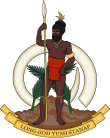| Independent Commune of FrancevilleCommune Indépendante de Franceville (French) | |||||||||
|---|---|---|---|---|---|---|---|---|---|
| 1889–1890 | |||||||||
 Flag
Flag | |||||||||
 1905 map of New Hebrides, still showing Franceville as alternative name for Port Vila 1905 map of New Hebrides, still showing Franceville as alternative name for Port Vila | |||||||||
| Status | Unrecognized state | ||||||||
| Common languages | French, Bislama | ||||||||
| Government | Republic | ||||||||
| • 1889 | Ferdinand Chevillard | ||||||||
| • 1890? | R. D. Polk | ||||||||
| Deputy (legislator) | |||||||||
| • 1889–1890 | Comte Maurice de Nolhac | ||||||||
| Historical era | New Imperialism | ||||||||
| • Established | August 9 1889 | ||||||||
| • Disestablished | June 1890 | ||||||||
| Population | |||||||||
| • 1889 | 540 | ||||||||
| |||||||||
Franceville (present-day Port Vila) was a municipality located on Efate, or Sandwich Island. It was established in 1889 in order to gain basic legal status, during the period when the New Hebrides was a neutral territory under the loose jurisdiction of the Anglo-French Joint Naval Commission.
History
In 1878, the United Kingdom and France declared all of the New Hebrides to be neutral territory. For the protection of the French and British citizens in New Hebrides, a joint naval commission was established under the Convention of 16 October 1887. However, the convention claimed no jurisdiction over internal native affairs.
The lack of a functional government led to rising discontent among the colonists. The French were especially inconvenienced because French law only recognized marriages when contracted under a civil authority (the nearest one being in New Caledonia), whereas British law recognized marriages conducted by local clergy. On 9 August 1889, Franceville declared itself an independent commune under the leadership of elected mayor/president Ferdinand-Albert Chevillard, and with its own red, white and blue flag with five stars.
This community became one of the first self-governing nations in recorded history to practice universal suffrage without distinction of sex or race. Although the district's population at the time consisted of about 500 natives and fewer than 50 whites, only white males were permitted to hold office. One of its elected presidents was R. D. Polk, a native of Tennessee and relative of James K. Polk.
The new government was soon suppressed, and by June 1890, Franceville as a commune was reported to have been "practically broken up." An 1891 census reported 29 adult Europeans, making it the largest European settlement in the New Hebrides. In 1906, the naval commission was replaced by a more structured British-French Condominium.
See also
References
- "Arrangement between Great Britain and France, respecting the Independence of the New Hebrides Group" (PDF). January–February 1878. Archived from the original (PDF) on 29 February 2012. Retrieved 22 January 2010.
- Le Gouz de Saint-Seine, Jean (1897). "Notice sur les Nouvelles-Hébrides". Mémoires de la Société bourguignonne de geographie et d'histoire. 13: 413–414.
- Bourdiol, Julien (1908). Condition internationale des Nouvelles-Hebrides. p. 107.
- Pelatan, Louis (1889). Lettres calédoniennes. Impr. du Colon. p. 73.
- Sydney Morning Herald, Aug 26, 1889
- "The 'Commune' of Franceville," North Otago Times (New Zealand), Sep 5, 1889
- Imhaus, E.N. (1890). Les Nouvelles-Hébrides: avec une carte et sept gravures. pp. 154–160.
- Simpson, Colin (1955), Islands of Men: A Six-part Book about Life in Melanesia, p 133
- "Wee, Small Republics: A Few Examples of Popular Government," Hawaiian Gazette, Nov 1, 1895, p 1
- "Wee, Small Republics: A Few Examples of Popular Government," Hawaiian Gazette, Nov 1, 1895, p 1
- "Some Little Republics," New York Evangelist, Feb 20, 1896
- "Latest Cable News: Australian News," The West Coast Times (New Zealand), June 28, 1890, p 2
- "VILA—THE TOWN THAT JUST GREW", Pacific Islands Monthly, 40 (6): 95, 1 June 1969, ISSN 0030-8722
Further reading
- Brunet, Auguste (1908). Le régime international des Nouvelles-Hébrides: Le Condominium Anglo-Français. pp. 64–65.
- Cawsey, Katherine Stirling Kerr (1998). The Making of a Rebel: Captain Donald Macleod of the New Hebrides. Editorips@usp.ac.fj. pp. 391–403. ISBN 978-982-02-0140-8.
- Davillé, Ernest (1895). La colonisation française aux Nouvelles-Hébrides.
- O'Reilly, Patrick (1957). Hébridais, répertoire bio-bibliographique des Nouvelles-Hébrides.
17°44′15″S 168°18′50″E / 17.73750°S 168.31389°E / -17.73750; 168.31389
| Vanuatu articles | |||||
|---|---|---|---|---|---|
| History |  | ||||
| Geography | |||||
| Politics | |||||
| Economy | |||||
| Society |
| ||||